 Arriving just eight months after the announcement of the upmarket D200, Nikon’s new D80 builds on the success of 2004’s D70, offering a slew of enhancements, a larger LCD and an inevitable upping of the pixel count.
Arriving just eight months after the announcement of the upmarket D200, Nikon’s new D80 builds on the success of 2004’s D70, offering a slew of enhancements, a larger LCD and an inevitable upping of the pixel count.
The D80 increases the pixel count by 67% on its predecessor to 10.2 megapixels, and manages to shrink the package down to more or less the size of the entry level D50 dSLR.
Although the reduction in size is welcome, it’s still quite a hefty beast compared to models from Olympus and Pentax, although there’s not a great deal of difference in bulk between rival cameras from Sony and Canon.
The D80 manages to borrow some of the high end features of the some of the company’s high-end cameras, inheriting the processing engine of the Nikon D2X, and the Nikon D200’s Multi CAM 1000 AF system, CCD, LCD and viewfinder.
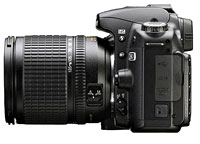 Clearly this mix’n’match approach makes sense for cost-aware Nikon, with interchangeable components helping to keep the prices down in a hugely competitive market, although the differences in build quality between the D80 and its big brother are clearly marked.
Clearly this mix’n’match approach makes sense for cost-aware Nikon, with interchangeable components helping to keep the prices down in a hugely competitive market, although the differences in build quality between the D80 and its big brother are clearly marked.
SD card
Users upgrading from the D70 may be mightily unchuffed to discover that Nikon has switched from Compact Flash to SD memory cards.
Capable of supporting the new Secure Digital High Capacity (SDHC) cards, this opens up potential capacities of up to 32GB and may help tempt users of compact cameras already using SD cards.
At the back of the camera we could see useful improvements to the button layout, and the 2.5″ LCD screen seemed positively enormous compared to the squinty 2″ screen on the D70.
 Interface upgrades
Interface upgrades
The on-screen user interface had also been considerably spruced up, using the same high resolution and anti-aliased fonts from the D200. The new image review zoom in/out controls improve massively on the fiddly controls of the D70.
The bigger, brighter 0.94X magnification viewfinder was equally well received; we loved the addition of the light switch to the on/off control and quickly felt right at home with the tweaked top plate layout.
ISO range has been improved to cover 100ISO right up to ISO3200 (with boost) with 0.3EV steps, backed by the same three custom NR (Noise Reduction) settings from the Nikon D200.
New editing menus offer built-in D-Lighting, Retouch Menu and Redeye removal capabilities, with a Pictmotion feature letting users playback images as slideshows.
 There’s also a host of new customisation options (a total of 32 custom functions) letting photographers set up the D80 to their needs.
There’s also a host of new customisation options (a total of 32 custom functions) letting photographers set up the D80 to their needs.
Flash
Less good is the flash sync speed dropping down to 1/200, although we’re doubtful that most users will ever notice the difference.
The electronic-release pop-up flash raises automatically in appropriate Auto modes or can be triggered manually by pressing the flash button.
The flash offers a guide number of 13 (m at ISO 100) and can also act as a commander in a wireless flash setup.
Speed
We found the D80 to be a very, very fast performer, with a near-instantaneous start-up and barely measurable shutter lag ensuring we didn’t miss a shot.
With an eye to point’n’shooters, new Black & White modes offering additional Sepia and Cyanotype options have been included, along with the usual Program, Aperture priority, Shutter priority, Manual, Auto and six programmed modes (including a new Night Landscape mode).
Matrix metering inconsistencies
The D80 comes with Nikon’s smartypants 3D Colour Matrix Metering II automatic exposure control which consults a database of more than 30,000 actual photographic scenes to help evaluate brightness, colour, contrast, selected focus area and camera-to-subject distance.
Although it generally worked well in our tests, a couple of times it threw up some clearly over-exposed scenes, which suggests that it’s not quite as user-friendly as Nikon suggest (in fact, this issue has been a hot topic on the dpreview forums with photographer Ken Rockwell declaring his D80 meter to be “the worst of any Nikon I’ve used in 20 years.”)
Although a deft bit of dialling down with the exposure compensation button can fix this easily enough, it does seem markedly different to how the D70 metered and that’s something users will have to get used to.
Conclusion
Overall, we were very impressed with the D80. It feels like a significant step up from the D70, punching above its weight in features, usability and performance.
 The camera is easy to use, feels right in the hand with all the main controls falling easily to hand, and looks like it could take the occasional knock.
The camera is easy to use, feels right in the hand with all the main controls falling easily to hand, and looks like it could take the occasional knock.
The improved viewfinder provides a big, bright view with the larger LCD screen and updated interface adding to the feeling that this is a real ‘photographers camera.’
Minor metering issues aside, images were crisp, clean and vibrant, with an improved high ISO performance making the camera a versatile performer in all conditions.
Although it’s priced ahead of its main rivals, the Canon EOS 400D and Sony Alpha, we feel that the D80 is well worth the extra outlay and offers the best all-rounder 10 megapixel DSLR of the bunch to date. Highly recommended.
Our verdict
Features: 90%
Ease of Use: 90%
Image Quality: 95%
Overall: 95%
Street price (body only) approx £599 (~$900, ~€585)
Nikon D80 main specifications
- 10.2 megapixels
- 11-area Multi-Cam 1000 AF system
- ISO sensitivity range ISO100 to ISO1600 plus HI-1(equivalent ISO3200)
- SDHC compatible
- 2.5inch LCD screen
- File formats – Compressed NEF or JPRG
- Compatible with all Nikon AF lenses.
- 3D colour matrix metering II, and centre-weighted or spot metering modes
- Exposure metering range – EV0 to EV20 with 3D colour matrix or centre weighted metering
- Exposure compensation up to +/-5EV
- Shutter speed range – 30secs to 1/4000sec and bulb
- Flash synch up to 1/200sec
- Flash compensation -3 to +1EV
- Depth-of-field preview
- Rechargeable EN-EL3e Li-ion battery
- Dimensions 132mm(W) x 103mm(H) x 77mm(D)
- Weight – 585g without battery
Full D80 review at DPReview
 If you’re finding that the built-in flash on your compact camera has the illuminating power of a Woodbine in a gale force breeze, it might be worth investing in the Metz 28 CS-2 Digital slave flash.
If you’re finding that the built-in flash on your compact camera has the illuminating power of a Woodbine in a gale force breeze, it might be worth investing in the Metz 28 CS-2 Digital slave flash.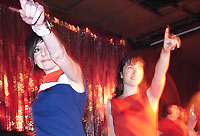 To ensure that the Metz fires at the same time as the camera’s onboard flash, the unit can be put in a learning mode which calculates and stores the correct flash trigger.
To ensure that the Metz fires at the same time as the camera’s onboard flash, the unit can be put in a learning mode which calculates and stores the correct flash trigger. It took a matter of seconds to ‘train’ the Metz to fire at the same time as the Ricoh’s onboard flash and we had no problems getting it to respond to each and every subsequent shot.
It took a matter of seconds to ‘train’ the Metz to fire at the same time as the Ricoh’s onboard flash and we had no problems getting it to respond to each and every subsequent shot. Rating
Rating Global sales of camera phones are set to make up nearly half of the total of all mobile phone sales this year, with the figure expected to rise to 81 percent of all phones by 2010.
Global sales of camera phones are set to make up nearly half of the total of all mobile phone sales this year, with the figure expected to rise to 81 percent of all phones by 2010. “In 2006, 1.3 and two mega pixel resolutions will become the minimum requirement for mid-tier to high-end phones and a 3.2 mega pixel resolution will be used for flagship products. This will increase to five mega pixels in 2007,” Milanesi said.
“In 2006, 1.3 and two mega pixel resolutions will become the minimum requirement for mid-tier to high-end phones and a 3.2 mega pixel resolution will be used for flagship products. This will increase to five mega pixels in 2007,” Milanesi said. Producing high quality, well-lit, studio-style photographs can be quite a challenge if you don’t happen to have access to a studio set-up at home or be the proud owner of an expensive camera.
Producing high quality, well-lit, studio-style photographs can be quite a challenge if you don’t happen to have access to a studio set-up at home or be the proud owner of an expensive camera. The Cubelite cubes come in a range of sizes, from two foot up to six foot six inches, with each package including a 500w tungsten light and tripod, two-sided silver and white reflector, white background and carry case.
The Cubelite cubes come in a range of sizes, from two foot up to six foot six inches, with each package including a 500w tungsten light and tripod, two-sided silver and white reflector, white background and carry case. Unleashing the beast
Unleashing the beast Following the straightforward instructions, we stuck the lamp on the tripod and set it up so that it shone it through the fabric from a distance of 18 inches.
Following the straightforward instructions, we stuck the lamp on the tripod and set it up so that it shone it through the fabric from a distance of 18 inches. A useful, albeit minimal, single sheet of A4 paper advised us on how to sort out the colour balance on our camera, and before long we were knocking out some s-s-s-studio style photos with ease, with the diffusing material making it a cinch to grab attractive, shadow-free results.
A useful, albeit minimal, single sheet of A4 paper advised us on how to sort out the colour balance on our camera, and before long we were knocking out some s-s-s-studio style photos with ease, with the diffusing material making it a cinch to grab attractive, shadow-free results. We found the Cubelite easy to lug about, although the towering tripod and heavy duty lamp may have bordered on overkill for such a small set up.
We found the Cubelite easy to lug about, although the towering tripod and heavy duty lamp may have bordered on overkill for such a small set up.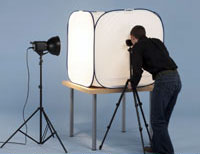 Rating
Rating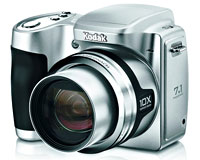 With the Photokina 2006 photo fair opening its gates for business, the big guns are rolling out new product announcements at a rate of knots, and Kodak has offered details of their budget-priced 7.1-megapixel EasyShare Z710 Zoom.
With the Photokina 2006 photo fair opening its gates for business, the big guns are rolling out new product announcements at a rate of knots, and Kodak has offered details of their budget-priced 7.1-megapixel EasyShare Z710 Zoom. At the rear there’s a (now) rather miserly 2″ LCD, plus the standard array of controls and an optical viewfinder (we like them).
At the rear there’s a (now) rather miserly 2″ LCD, plus the standard array of controls and an optical viewfinder (we like them). Kodak are claiming that the 7.1 megapixel image sensor and ‘professional quality’ Schneider Kreuznach Variogon 10X optical zoom lens are capable of capturing high-quality prints up to 30 x 40 inches (76 x 102 cm), helped by their Kodak Color Science imaging processing chip.
Kodak are claiming that the 7.1 megapixel image sensor and ‘professional quality’ Schneider Kreuznach Variogon 10X optical zoom lens are capable of capturing high-quality prints up to 30 x 40 inches (76 x 102 cm), helped by their Kodak Color Science imaging processing chip. We get to see an awful lot of gadgets here at Digital-Lifestyles, so it’s not surprising we get quite a few emails asking what gizmos we personally use, so here’s my personal choices. And yes, I paid for ’em all myself!
We get to see an awful lot of gadgets here at Digital-Lifestyles, so it’s not surprising we get quite a few emails asking what gizmos we personally use, so here’s my personal choices. And yes, I paid for ’em all myself! Camera
Camera Clad is an understated logo-free black body, this isn’t a camera that’s going to get people’s attention when you’re out and about, but its armoury of full manual controls and user configured settings means that it’s a great carry-around shooter.
Clad is an understated logo-free black body, this isn’t a camera that’s going to get people’s attention when you’re out and about, but its armoury of full manual controls and user configured settings means that it’s a great carry-around shooter. Enjoying a daily hammering of ska, punk, electro and indie tunes is the
Enjoying a daily hammering of ska, punk, electro and indie tunes is the  Now in its third year (that must be something like 70 years old in laptop years!), my Sony Vaio SRX51P is still doing the business, although with a mere 850 MHz Pentium III-M CPU and just 384 meg RAM on board, it can’t keep up with the new boys.
Now in its third year (that must be something like 70 years old in laptop years!), my Sony Vaio SRX51P is still doing the business, although with a mere 850 MHz Pentium III-M CPU and just 384 meg RAM on board, it can’t keep up with the new boys.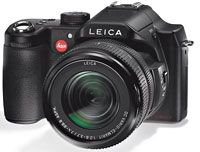 There’s been a flurry of interesting announcements from some of the photographic bigwigs leading up to the Photokina ‘World of Imaging’ Trade Show, which is held every two years at the Cologne Exhibition Centre, Germany.
There’s been a flurry of interesting announcements from some of the photographic bigwigs leading up to the Photokina ‘World of Imaging’ Trade Show, which is held every two years at the Cologne Exhibition Centre, Germany. Leica DIGILUX 3 dSLR
Leica DIGILUX 3 dSLR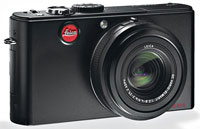 Leica V-LUX 1
Leica V-LUX 1 Canon PowerShot SD900
Canon PowerShot SD900 Impressively, the $449 / €449 camera offers a wideangle 3.8x zoom (28-105mm) along with the usual zillions of scene modes.
Impressively, the $449 / €449 camera offers a wideangle 3.8x zoom (28-105mm) along with the usual zillions of scene modes.
 Great oceans of dribbling saliva could be seen around the photography desk at Digi-Lifestyle towers today as we caught sight of the eagerly awaited Leica M8 Digital Rangefinder camera.
Great oceans of dribbling saliva could be seen around the photography desk at Digi-Lifestyle towers today as we caught sight of the eagerly awaited Leica M8 Digital Rangefinder camera. Leica used some Teutonic cunning to get around the problem of corner vignetting on older lenses by employing a smaller sensor, offset microlenses and software correction optimised for the lens in use.
Leica used some Teutonic cunning to get around the problem of corner vignetting on older lenses by employing a smaller sensor, offset microlenses and software correction optimised for the lens in use. Rangies aren’t for everyone though. The lack of autofocus and limited availability of long telephoto lenses means that you’ll need an experienced hand to grab action/sports photographs, and there’s no hand-holding ‘scene’ modes on this puppy.
Rangies aren’t for everyone though. The lack of autofocus and limited availability of long telephoto lenses means that you’ll need an experienced hand to grab action/sports photographs, and there’s no hand-holding ‘scene’ modes on this puppy. Inside is the three-position shutter release button (prime exposure/ exposure lock/shutter release) with an old fashioned shutter speed dial to the left (we like these).
Inside is the three-position shutter release button (prime exposure/ exposure lock/shutter release) with an old fashioned shutter speed dial to the left (we like these). As with previous Leica designs, the camera is clear and easy to understand, simple and graceful throughout. And eye-wateringly expensive.
As with previous Leica designs, the camera is clear and easy to understand, simple and graceful throughout. And eye-wateringly expensive. Fujifilm have announced the FinePix A700 compact digital camera, a shiny new addition to their entry-level ‘A’ series camera range.
Fujifilm have announced the FinePix A700 compact digital camera, a shiny new addition to their entry-level ‘A’ series camera range. Unlike Fujifilm’s more upmarket offerings, their famous high ISO settings are nowhere to be found on the A700, which can only offer a comparatively restricted 100 to 400 ISO sensitivity with no anti-shake.
Unlike Fujifilm’s more upmarket offerings, their famous high ISO settings are nowhere to be found on the A700, which can only offer a comparatively restricted 100 to 400 ISO sensitivity with no anti-shake. Fujifilm FinePix A700 specifications
Fujifilm FinePix A700 specifications Sony has announced two new cameras shunting off their ever-busy production line, the Sony Cyber-shot DSC-T50 and DSC-N2, both offering large LCD screens.
Sony has announced two new cameras shunting off their ever-busy production line, the Sony Cyber-shot DSC-T50 and DSC-N2, both offering large LCD screens. Shipping in (ahem) ‘bold’ red, black and silver, the DSC-T50 offers 56 MB of internal memory (with Memory Stick Duo/ PRO Duo memory cards allowing storage expansion up to 4GB) and sizes up at just 95×56.5×23.4 and 170g.
Shipping in (ahem) ‘bold’ red, black and silver, the DSC-T50 offers 56 MB of internal memory (with Memory Stick Duo/ PRO Duo memory cards allowing storage expansion up to 4GB) and sizes up at just 95×56.5×23.4 and 170g. Sony DSC-N2
Sony DSC-N2 “With digital photography, the social interaction that happens when people share their pictures has become as important as making great photographs,” insisted Phil Lubell, director of marketing for digital still cameras and photo printers at Sony Electronics.
“With digital photography, the social interaction that happens when people share their pictures has become as important as making great photographs,” insisted Phil Lubell, director of marketing for digital still cameras and photo printers at Sony Electronics.